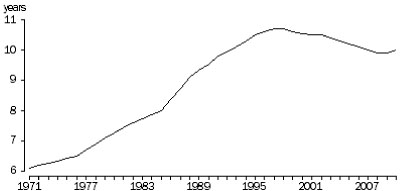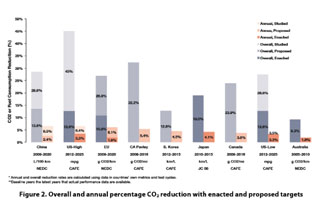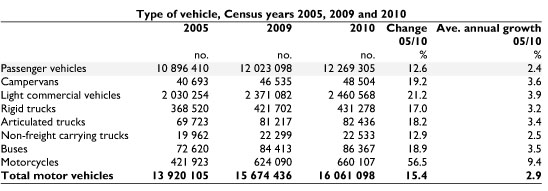
Australia Automotive Fuel Economy Policy
1.1 Background
Although Australia does not yet have a mandatory automotive fuel economy standard, the Federal Chamber for Automotive Industries established a voluntary target in 2005 to reduce National Average Carbon Emissions (NACE) for all new passenger vehicles to 222 grams of CO2/km under the NEDC driving test cycle by 2010. There are no specified enforcement or non-compliance penalties under this agreement.
1.2 Australia Light-Duty Vehicle Fleet
There were 16.1 million motor vehicles registered in Australia as of 31 March 2010, of which 12.2 million were passenger (or light duty, LDV) vehicles. The average annual growth over the 2005 – 2010 period for LDV’s was 2.4%.
In the 5 years between 31 March 2005 and 31 March 2010, the LDV fleet grew 12.6% to 12.3 million. In 2010, the average age of all vehicles registered in Australia was 10 years old.
Estimated Average Vehicle Age of vehicle fleet.
13.3 million vehicles (or 83% of the total vehicle fleet) were registered as petrol vehicles. The number of vehicles registered with diesel fuel as of 31 March 2010 accounted for 13.8% (or 2.2 million vehicles) of the total fleet, up from 10.1% in 2005.
Motor vehicle fleet, Type of fuelOver the five year period, passenger vehicle registrations increased by 12.6%; diesel fuel vehicle registrations increased by 91.5%. Over the same period, registrations for light commercial diesel vehicles was 64.3% higher.
1.3 Status of LDV fleet fuel consumption/CO2 emissions
Overall, the impact of the voluntary standards has been modest in Australia (see below) and the government is now developing mandatory standards.

Overall and annual percentage CO2 reduction with enacted and proposed targets. Courtesy of www.theicct.org.
2.0 Regulatory Policies
2.1 National Standard
The Federal Chamber of Automotive Industry first established voluntary fuel economy standards for new vehicles sold in Australia in 1978; although the industry did not achieve the targets, there was still noticeable improvement in fuel economy. A second voluntary code, in place from 1996 to 2001, aimed to reduce the national average fuel consumption to 8.2L/100km. In 2005, FCAI members committed to a voluntary target of 222 grams of CO2/km for petrol passenger cars to be attained by 2010. This represented a 15% improvement in the fuel efficiency of new vehicles between 2002 (as the baseline) and 2010. With all three voluntary standards, there were no penalties or enforcement.
2.2 Test cycle type
Australia uses the “New European Driving Cycle”, or NEDC.
2.3 Import restrictions
New Vehicles
Australian new and used vehicle imports must adhere to national emission standards, meaning Euro 4 standardsfor conventional pollutants for LDV’s as of mid 2010.
Second Hand
N/A
2.4 Technology mandates/targets
N/A
3.0 Fiscal Measures and Economic Instruments
3.1 Fuel Taxes
N/A.
3.2 Fee-bate
N/A
3.3 Buy-back
In 2009 the Australian government introduced a tax break giving consumers a 30 percent discount on purchasing new motor vehicles. The tax break was part of the government’s $42 billion Nation Building and Jobs Plan to create up to 90,000 Australian jobs. Some $2.7 billion has already been spent on increasing vehicle sales by giving beneficial tax incentives. But, unlike similar programs (e.g. the U.S. ‘Cash for Clunkers’ programme) Australia’s program did not carry any special efficiency requirement when purchasing a new car.
3.5 Other tax instruments
N/A
3.6 Registration fees
N/A
3.7 R&D
N/A
4.0 Traffic Control Measures
4.1 Priority lanes
N/A
4.2 Parking
N/A
4.3 Road pricing
N/A
5.0 Information
5.1 Labeling
Australia instituted a mandatory labelling scheme in 2001; for more information on Australia’s labeling program, click here. The results are based on a standard test procedure so consumers can reliably compare the performance of different models under the same test conditions (see test cycles for more on testing procedures for emissions).
5.2 Public info
5.2 Public Info
The Australian government publishes a Green Vehicle Guide which rates all new Australian passenger, four-wheel drive and light commercial vehicles based on fuel consumption, and greenhouse and air pollution emissions. Data is available from models from 1986 onwards.
5.3 Industry reporting
N/A
The text above is a summary and synthesis of the following sources:
- Australian Bureau of Statistics.http://www.abs.gov.au/ausstats/abs@.nsf/mf/9309.0/
- “Comparison of Passenger Vehicle Fuel Economy and Greenhouse Gas Emission Standards Around the World.” Pew Center on Global Climate Change, 2004. http://www.pewclimate.org/global-warming-in-depth/all_reports/fuel_economy.
- Greengarten, L. “Critics Say Australia Forgot About Efficiency.” The New York Times. September 2009. (http://green.blogs.nytimes.com/2009/09/16/critics-say-australia-forgot-about-efficiency/)
- Fulton, L. "International Comparison of Light-duty Vehicle Fuel Economy and Related Characteristics." International Energy Agency Working Paper Series, 2010: 1-70.
- “Improving Vehicle Fuel Economy in the ASEAN.” Clean Air Initiative for Asian Cities (CAI-Asia) Center. July 2010.http://www.globalfueleconomy.org/Documents/Publications/wp1_asean_fuel_economy.pdf
- “Passenger Vehicle Greenhouse Gas and Fuel Economy Standards: A Global Update 2011.” The International Council on Clean Transportation. http://www.theicct.org/info/documents/PVstds_update_jan2011.pdf
- “Passenger Vehicle Greenhouse Gas and Fuel Economy Standards: A Global Update 2007.” The International Council on Clean Transportation. http://www.theicct.org/pubs/PV_standards_2007.pdf
- “Review of International Policies for Vehicle Fuel Efficiency.” International Energy Agency. 2008. http://www.iea.org/papers/2008/Vehicle_Fuel.pdf









